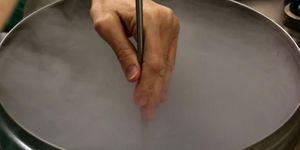
They say that in space, no one can hear you scream. They can smell you however, at least according to retired astronaut Clayton C. Anderson and NASA Engineer Robert Frost. The two recently provided some insight on how the ISS manages odor.
Frost explained that odors on the ISS come from several sources. There is equipment off-gassing, lab experiments, food odors and something he refers to as "crew metabolic processes."
From an engineering standpoint, odor is chemical in nature and can be eliminated in much the same way. In the Service Module odor is eliminated via a Micropurification Unit. Air is drawn out by fans and passed over charcoal beds that are laden with phosphoric acid to break down ammonia. From here, the air splits into two streams, one of which leads to a Catalytic Oxidizer Assembly. Contaminants with high molecular weights are vented to a simple bypass line, however one of the most problematic odors, methane gas, has a lower molecular weight and must be treated by passing it through the Catalytic Oxidizer Assembly since lighting a match is not feasible.
The oxidizer heats the methane laden air to approximately 400 ° C. Organic compounds are reduced to CO2 and water; inorganic compounds are converted to acidic gases. The air is then cooled and passed over a lithium hydroxide sorbent bed, which removes the acids created in the oxidation process. Air exiting the assembly at this stage is then mixed with the air in the bypass line and returned to the ducts, without the telltale odor that often results from having beans for lunch.
The crew aboard the ISS is definitely living better through chemistry, however retired astronaut Clayton Anderson says that chemistry only goes so far in the close quarters of the space station. While the high tech filters and oxidizers performed well most of the time, there were a few minor issues. Anderson has plenty of real life experience, having spent 159 days aboard the ISS. He explained that food odors and the stink of sweaty workout gear were the main obstacles to keeping the ISS environment fragrance-free.
While some would think the toilet system would be the cause of most odors, that wasn't actually the case. The airflow systems in the lavatories would literally pull the waste immediately into filters deep in the ISS, where the offending gases were neutralized. Food and funk seemed to be the real culprits. Anderson recalls that a particular dish, the US version of seafood gumbo, was often outlawed by mission commanders because of its pungent odor and distinct after effects. Sweat soaked clothing, socks especially, were also a concern. Anderson said he would hang his damp duds on a handrail near an air conditioning vent where they would dry completely by the next day.
The one smell Anderson could not describe easily but is unique and recognizable was the smell of space. Crewmembers coming in from space walks would carry an odor with them that Anderson says was like no other. "Ever distinct --I would know it instantly if I smelled it-- it has been likened to smells associated with welding or burning of ozone (now who the heck really knows what that smells like?!)"
For crew members aboard the ISS, staying as fresh as a daisy isn't as easy as it might be at home, but the view more than makes up for it.
 They say that in space, no one can hear you scream. They can smell you however, at least according to retired astronaut Clayton C. Anderson and NASA Engineer Robert Frost. The two recently provided some insight on how the ISS manages odor.
They say that in space, no one can hear you scream. They can smell you however, at least according to retired astronaut Clayton C. Anderson and NASA Engineer Robert Frost. The two recently provided some insight on how the ISS manages odor.







